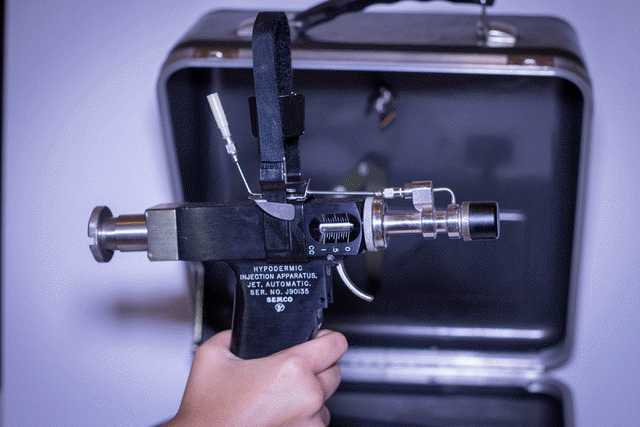|
|
||||||||||||||||||||||||||||||||
|
|
||||||||||||||||||||||||||||||||
|
http://www.aidsmap.com/Managing-common-side-effects-of-hepatitis-C-protease-inhibitors/page/2221599/
Common side-effects of hepatitis C protease inhibitors: clinical management advice published New and experimental hepatitis C treatment > Michael Carter Published: 20 January 2012 The addition of the protease inhibitors telaprevir or boceprevir to hepatitis C treatment regimens increases the risk of anaemia, according to a review article published in Liver International. The author also found that telaprevir treatment was associated with an increased risk of rash and itching as well as some anorectal symptoms. However, these side-effects were generally mild and could be managed without the need to discontinue therapy. Telaprevir (Incivek / Incivo) and boceprevir (Victrelis) were recently approved for the treatment of hepatitis C genotype-1 monoinfection in combination with pegylated interferon and ribavirin. Clinical trials showed that taking either of these drugs in combination with pegylated interferon and ribavirin improved rates of sustained virological response compared to therapy with pegylated interferon and ribavirin alone. The same studies also showed that the addition of these drugs also increased the risk of a number of side-effects such as itchy skin, rash, neutropenia, anaemia and gastrointestinal disorders such as nausea, diarrhoea and anorectal symptoms. Side-effects can affect adherence to therapy or lead to its premature discontinuation. An understanding of their severity and management is essential to the optimum management of patients taking hepatitis C therapy in routine clinical care.
Therefore Dr Christophe Hézode of the Hôpital Henri Mondor, Paris, reviewed the
results of phase II/III studies undertaken during the development of both
telaprevir and boceprevir.
These showed that both drugs increased the risk of anaemia. Approximately 50% of patients treated with boceprevir developed anaemia as did 40% of those taking telaprevir. It is thought that this is because both drugs have a suppressive effect on bone marrow. It is already known that anaemia can be a side-effect of ribavirin. The addition of either protease inhibitor appears to lead to its exacerbation. The impact of anaemia on the chances of sustained virological response was different for telaprevir and boceprevir. The side-effect had no effect on treatment responses in naïve patients treated with telaprevir. However, boceprevir studies involving treatment-naïve and treatment-experienced patients showed that the presence of anaemia was associated with better outcomes. Premature discontinuation because of anaemia was rare. Management strategies can include the use of supportive therapies or ribavirin dose reduction. The latter should only be considered in certain circumstances. In the boceprevir studies, 43% of patients with anaemia received supporting therapy with erythropoietin (EPO). However, the author believes that such a strategy would be problematic in routine care. Anaemia was managed in approximately a quarter of patients with a reduction in ribavirin dose. This did not appear to affect the chances of achieving a sustained virological response. In the boceprevir studies, only a ribavirin dose reduction of 60% or more of the planned initial dose affected virologic outcomes. Reducing the ribavirin dose when hepatitis C viral load was undetectable appeared to be the safest option. However, use of EPO meant that full-dose ribavirin could often be maintained, the supportive therapy leading to an improvement in patient quality of life. For treatment-experienced patients, both protease inhibitors were associated with high rates of anaemia (40-57%). Many of these individuals had liver cirrhosis. EPO therapy was provided to 41-45% of patients and 4-17% required a blood transfusion. “Triple therapy must be administered cautiously with intensive safety monitoring, including anaemia, in patients with cirrhosis,” writes the author. Dermatological reactions are well-known side-effects of dual hepatitis C therapy with pegylated interferon and ribavirin. Their risk seems to be increased by the addition of a protease inhibitor, especially telaprevir. In phase II/III studies 55% of patients treated with telaprevir developed a rash compared to a third of those in the placebo arm. This rash was similar to that associated with standard hepatitis C therapy. However, the addition of telaprevir made it more extensive and severe. The majority of rashes involved eczema and itch. Over 90% were mild or moderate and involved less than 30% of skin area. Progression to a more severe rash was rare. Rashes could develop anytime during telaprevir therapy. The excess risk associated with the drug disappeared after therapy was completed. Overall incidence of a serious rash was 5% in the telaprevir study arms compared to below 0.4% in the placebo arms. Rates of treatment discontinuation because of severe rash were 6% for the telaprevir-treated patients and 3% of individuals taking dual therapy. A few cases of cases of rash were classified as severe cutaneous adverse reactions, which can be life threatening. There were two confirmed/suspected instances of treatment-related Stevens Johnson Syndrome. All severe reactions resolved when telaprevir therapy was stopped. Dr Hezode says that physicians need to be able to distinguish between manageable dermatitis, severe rash and a severe cutaneous adverse reaction. Localised rash, or a diffuse rash covering less than 50% of the body surface area, should be manageable, but requires close monitoring for signs of progression. If the rash continues to progress telaprevir should be discontinued, and if the rash does not improve within seven days, ribavirin should also be discontinued. In cases of severe rash covering at least half the body surface, or where the rash is accompanied by systemic symptoms such as fever, or where ulceration, skin peeling or other lesions are present, a dermatologist should be consulted. Telaprevir should be discontinued and if there is no improvement within seven days ribavirin and/or pegylated interferon should also be discontinued. In the most severe cases, where systemic symptoms are present together with eosinophilia, or where Stevens-Johnson syndrome has developed, all drugs should discontinued immediately and the patient should be hospitalised. Less serious rash can be managed by: Emollient creams to treat eczematous rash Topical corticosteroids Systemic antihistamines (not astemizole or terfenadine) Baking soda (half cup) or oatmeal in bath water Wearing loose fitting clothes Telaprevir has also been associated with an increased risk of anorectal symptoms (26% vs. 5% placebo).This usually developed during the first two weeks of treatment and typically involved haemorrhoids, anal itching, discomfort and rectal burning. Most of these symptoms were mild or moderate and disappeared once telaprevir therapy was completed. However, in a few instances symptoms were so severe that treatment was stopped prematurely. An anal examination is recommended to exclude other causes that could cause similar symptoms. Management with topical creams and antihistamines is the preferred option. Both protease inhibitors are metabolised by the liver and can therefore interact with a number of other drugs. Contraindications for telaprevir include anticonvulsants such as phenytoin, as well as rifampicin, St John’s wort, some statins and erectile dysfunction drugs. Boceprevir has fewer known contraindications, but these include the antimalarials lumefantrine and halofantrine, some oral benzodiazepines, and a number of ergot derivatives. Reference Hézode C. Boceprevir and telaprevir for the treatment of chronic hepatitis C: safety management in clinical practice. Liver International 32: 32-38, 2012 (click here for the open-access article). |
|
|
|
|





